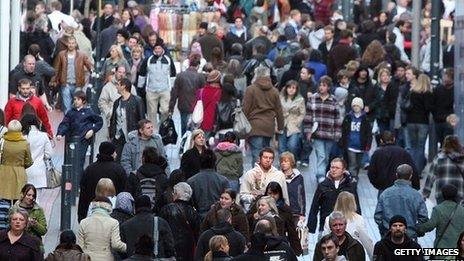Is cheap credit for small businesses the answer?
- Published
- comments

Firms are unlikely to expand until they believe the economy is stronger
The Bank of England believes that the continued serious weakness of the economy stems in part from the perceived reluctance of banks to lend to small businesses.
In extending by a year and broadening to other credit providers its scheme to supply cheap funds to banks - the Funding for Lending Scheme - the Bank of England is introducing a new incentive for small business lending.
For every extra pound that banks lend to small companies, they will be able to borrow £5 very cheaply from the Bank of England, and £10 if that lending takes place this year.
So banks that help small companies will receive what looks like a big subsidy (the interest rate charged will be 0.75%, unless - which is about as likely in the coming months as me being asked to come on as a substitute for Arsenal - the Bank of England increases the Bank Rate from 0.5%).
And the de facto bribe to banks to support smaller enterprises is biggest right now, on the eve of the official disclosure of just how anaemic the economy has been in the first three months of the year.
Befuddlement
There will be no ceiling on how much of this low-interest-rate money banks can borrow from the Bank of England. But they will only be able to obtain it if they are lending more than they are receiving back from customers in repayments - which was not true of RBS, Santander and Lloyds in the latter half of 2012, all of which shrank their so-called "net" lending.
Importantly, the measure of whether banks are increasing their net lending will be the sum of their respective lending to big businesses, mortgage lending to households, lending to non-bank providers of credit such as leasing and factoring companies and mortgage corporations, and either 10 or five times net loans to small enterprises.
To elucidate, they will be able to borrow an amount equal to their net lending, as calculated in that Heath-Robinson way.
If this is a bit befuddling, don't worry too much. All it really means is that banks are being pressurised into providing more credit to the economy than they take out of it, but with small business lending.
And, for what it is worth, the Treasury and the Bank of England - having talked to the banks - seem confident that more or less all of them will increase their overall net lending this year.
Weak demand
But, and this matters, neither the Bank of England or the Treasury are addressing the main cause of banks wariness when lending to small businesses, which is that they frequently see the risk of making losses as too great.
There's another thing, which you might call the "taking the horse to water" problem, and which the banks think is more important.
They say the main problem is that most small businesses don't actually want to borrow - that they would rather pay off their debts.
So, for example, cash placed on deposit by small businesses has been growing.
And the rate of applications for loans by small businesses to the market leader in small-business banking, Royal Bank of Scotland, is down a staggering 46% compared with before the 2007-08 financial crash.
Feeble economy
The point is that many companies don't want to borrow for the very reason that the Bank of England set up the Funding for Lending Scheme, which is that they regard the outlook for the economy as pretty grim - and fear that investing in new plant or stock would be throwing good money after bad.
So whether spraying cheap loans at them will address this fundamental problem, that the economy has been and remains so weak that it is still 3% smaller than it was in the first quarter of 2008, would be seen by many economists and business folk as moot.
PS: I will provide a few thoughts soon on the collapse of the Co-op's plans to be the new big force in retail banking, with its decision to abandon plans to buy 632 branches from Lloyds.